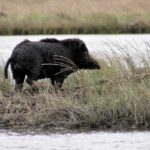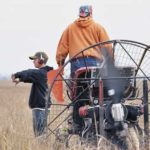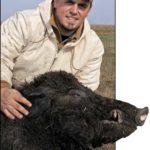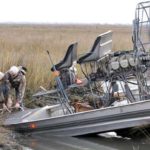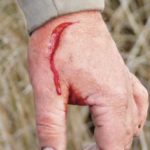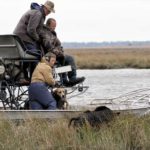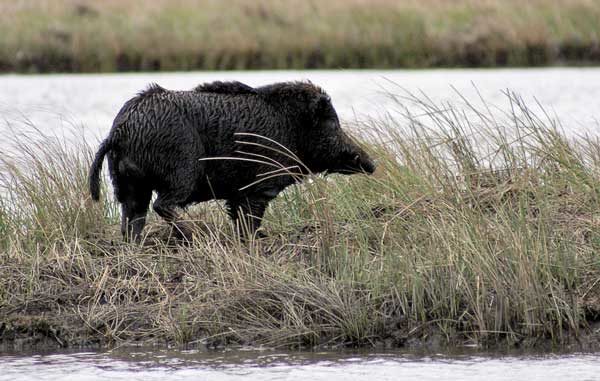
This group of hunters is fanatical about chasing down giant, wild-eyed boars in the marshes of South Louisiana.
Over the roar of several airboat engines, the bay dogs could be heard barking at the top of their lungs. The catch dogs were released, and suddenly, the piercing squeal of a dog-caught wild boar was added to the mix. Several brave men, and one brave woman, quickly leapt from the airboats to join in the fray. As promised, this was going to be a hunt like no other.
Mike Fradella lives in Slidell, and has been dog hunting wild boars in the marshes of South Louisiana for more than 30 years. Fradella and several friends first began chasing wild hogs in the marshy areas east of New Orleans.
“Where we used to hunt has now become the Bayou Sauvage National Wildlife Refuge,” Fradella said. “Hunting with firearms was not allowed in Orleans Parish, so other than a few trappers, we were the only ones hunting wild hogs in this area.”
In the old days, things were quite different. All of their hunting was done on foot. No matter where the hogs led the dogs, the group would have to follow.
“The hogs would regularly cross bayous and ponds, and the only way to keep up with them was to swim across,” Fradella said. “It was extremely physically demanding, and once you reached the hog, you had to have enough energy left to wrestle the hog and gain control of the dogs.”
Foot hunting, as Fradella calls it, was also much harder on the dogs.
“Sometimes these dogs would be nearly spent by the time they successfully bayed a big hog,” he said.
As the years progressed, Fradella’s group graduated to the use of three- and then four-wheeled ATVs in areas where the terrain permitted. The dogs were carried into the hunt in portable kennels on the ATVs, and were much fresher when the time came for them to do battle with an angry boar.
Once their prime hunting area became off limits, the group sought other destinations with large concentrations of wild hogs. Fradella and a group of dedicated hunters now lease a vast marsh and wooded area that straddles the Louisiana/Mississippi state line.
With more than 4,000 acres under their control, Fradella and his fellow hunters have created a hog-hunters’ heaven (yes, there really is a Hog Heaven). While there are still a few foot hunters in the group, Fradella has been using an airboat for many years as the primary mode of transporting hunters and dogs throughout the area.
The airboats, with their slick polymer bottoms glide easily over the marsh, and cause no damage. The grass is somewhat flattened, but it pops back up in short order.
“We’re careful not to repeatedly run over and over the same areas,” Fradella said. “We have been using airboats in the marsh for over a decade with no damage at all.”
The airboats can travel over virtually any flat surface, and are regularly launched on solid ground. Most are equipped with “cheater pumps” that spray a water solution to lubricate and cool the bottom when running over extremely dry surfaces. However, the marsh in Louisiana provides an ideal running surface because it is intermixed with dry and wet areas.
Some of the boats even have a system to inject nitrous oxide into the fuel system for a quick horsepower boost if they need a little extra push to get going or out of a tough spot.
On a recent winter weekend, Fradella and a group of friends from Florida planned two days of marsh hog hunting like no other. The Floridians eagerly made the 10-hour drive, and brought their own airboats and several hog dogs. The hunt was billed as the “most exciting hunt you will ever be on,” according to Fradella.
As we drove toward the hunt location, Fradella explained that “from the minute these airboats start running through the marsh, the excitement will not quit.”
On the first day, the group was composed of 15 hunters and five Diamondback airboats. One of the hunters was Bobby Fleckinger, president of Diamondback. Of all the hunters, Fleckinger seemed the most intense, and could not wait to catch a hog.
The boats were launched at a private area on the hunting lease. Fradella led the airboat armada to a cleared location in the marsh, where they unloaded groceries, chairs and extra fuel.
As hunt leader, Fradella gathered the troops to explain the game plan.
“We’ll spread the boats about a hundred yards apart,” he said. “If you get on a good boar, waive your flag for the other boats.”
The excitement started immediately. In less than five minutes, a large sow and several shoats (small, weaned piglets) burst through the marsh grass only a few feet in front of Fradella’s airboat. Not being the trophy boar sought, the group continued to roar through the tall marsh grass.
“What’s wrong with that airboat?” rang out over the headset intercom Fradella uses to communicate with his passengers. Mike’s son, Mathew, pointed to one of the group’s boats that was precariously angled in the otherwise flat marsh.
Fradella guided his airboat to where several of the others had gathered. It seems that the grass was just tall enough to hide a small canal winding through the marsh. The unlucky airboat took an unexpected nose dive, and buried its bow into the soft muddy bank. Yep, the excitement had started!
No one was injured and, amazingly, with a little pushing and pulling, bolstered by the powerful thrust of the propeller, the airboat was freed from its muddy entrapment. The hunt was back on.
Only five more minutes passed, and two of the boats were frantically waiving their orange flags signaling the sighting of a large boar. The airboats moved toward the hog for a closer look. With visual confirmation that this was indeed a trophy boar, two bay dogs were unleashed from the airboats.
Misty, Fradella’s prized Catahoula, led the charge. As large hogs are prone to do, this big boy didn’t go too far. He quickly stopped and held his ground as the bay dog team barked and nipped at his hind end to keep him twisting and turning. The rest of the airboats moved in for a closer look, and the boar’s large tusks could easily be seen from over 30 yards away.
With the hog successfully bayed, Fradella released his catch dog, Reed. Nearly simultaneously, one of the other boats also released a catch dog. Both dogs, wearing specially designed “cut collars,” which protect their critical areas from the boar’s tusks, rushed in to stop the unhappy hog in his tracks. In seconds, that hog had one pitbull and one blackmouth cur attached like a set of canine earrings.
Now it was the hunters’ turn. Fleckinger and Adam Nettles were the first to jump into the free-for-all. Fleckinger gained immediate control of the boar by grabbing its front leg and getting it turned on its side. Fleckinger’s well-placed knee on the boar’s neck kept the 200-plus-pound beast from getting back to its feet. Nettles and Mathew Fradella quickly went to work getting the dogs off of the hog. Others also joined in.
With dogs barking, the hog squealing and people shouting, it’s amazing that any participant in this dangerous marsh rodeo was coherent enough to maintain his role.
Then it happened.
“Adam’s cut,” someone yelled.
Nettles quickly retreated to the safety of his airboat while the others had to continue to get the situation under control. Hog one, hunters zero.
Blood was immediately evident on the front of Nettles’ hand, and he could not feel his thumb.
Now, there were two chaotic scenes playing out in one small section of marsh. While one group attended to the injured hunter, the other successfully removed the catch dogs and kept the boar secure. One of the dogs was also cut on his back leg. Hog two!
Although this boar was the first of the hunt, it was quickly decided that it was a true trophy. HoHo Brooks was looking for one for the wall, and this one was it. (HoHo, interestingly enough, hails from Christmas, Fla.).
With his wife Debbie nearby, Brooks used a large knife to quickly dispatch the beast that had just tried to eat his friend’s left hand.
Back to Adam. Though his hand was laid open like a filleted trout, the feeling had somewhat returned to his thumb, and it was determined that no veins or tendons were cut. He was very lucky.
Nettles is an experienced hog hunter, and his accident illustrates just how dangerous this sport can be.
“I was trying to get the dog off, and I reached in the wrong way and he got me,” Nettles said. “I’ll be alright, let’s hunt.”
Scotty McRae offered to do some down-home doctorin’ on the injured hunter’s hand. When one of the dogs gets cut, the dog handlers routinely have to sew or staple the wound. Perhaps it was the airboat emergency room or perhaps it was McRae’s rebel flag cap, either way, Nettles declined the offer.
There was also a brief discussion of the need to go to a real hospital. Nettles opted instead for as sterile a wash as could be done in the middle of the muddy marsh. Though still bleeding, some gauze and a pressure wrap bandage was used to dress his wound.
After all, the excitement had to continue.
And continue it did. The boats regrouped and again began gliding over the thick marsh grass. It seemed as if every few hundred yards, hogs of various sizes would flush from the grass and scurry in several directions. Many hogs were seen, sometimes as many as 20 at one time.
In the next two hours, the group caught two more trophy boars.
As a matter of practice, when a boar is spotted, the first thing the hunters look for is the tusks, which can be deadly weapons. It would be hard for even the most skilled knife sharpener to obtain an edge as sharp as some boar’s cutters.
The tusks are designed by nature to fit perfectly together when the boar’s mouth is closed. The upper “whetters” mesh with the longer cutters in the bottom jaw. The boars pop and grind these teeth together to keep them razor sharp.
When a boar is caught, you will immediately see him begin foaming at the mouth and hear the loud pops as he sharpens his weapons.
Now it was lunch time, and three trophy boars had already been caught. Before Hurricane Katrina, Fradella had a nice shelter in the middle of the marsh that served as a base camp for a Cajun version of a shore lunch. On this day, a scattered bale of hay and some folding chairs set under a make-shift tarpaulin would serve the purpose.
The Florida guests were treated to some great Louisiana gumbo cooked up by Harold Gourgues. For dessert, a Mardi Gras king cake and, of course, hogshead cheese. This was five-star dining in the middle of the marsh.
“Man, you guys sure know how to entertain,” said Floridian Rick Carroll.
As with dog hunting for any game, boar hunting with dogs is a social event. It’s just as much about the dogs and the comradery as it is about actually catching hogs. Unlike the solitude of still hunting, the hunters are able to share the excitement of the hunt as it is happening.
After lunch, it was back to the boats. In less than 15 minutes, the group was on the fourth and final trophy boar of the day. This one turned out to be a big black-and-white “bar” hog.
“A ‘bar’ hog is a boar that has been previously caught and castrated,” Fradella said.
He further explained that they manage the hogs on their property to keep as much of the Russian boar characteristics as possible.
“The Russian boars are solid black with brindle-tipped bristles. They also have a lot of wool undercoat,” he said.
By castrating these boars, it is believed that it makes the meat better for table fare, and the hogs grow very large. Also, it helps to keep more of the Russian strain within the herd.
“These bar hogs are unable to breed and pass their undesirable mixed color to the herd. Also, without the need to fight and search for sows to breed, they spend more time eating and become very large,” Fradella said.
The second day of the hunt proved even more exciting than the first. Though no injuries were had, many more hogs were seen, and the group caught and released six large, trophy-sized boars. The weather had turned bitter cold, and the hogs seemed to be much more active.
In just two days of hunting, 10 trophy boars were caught, with all but one released to fight another day. Including sows, shoats and small boars, the group collectively saw well over a hundred wild hogs.
Hunting with airboats may seem an unfair advantage to some. Fradella sees it as just the opposite.
“The use of the airboats certainly allows us easier access to the hogs’ marsh habitat,” he said. “However, it also allows us to get a look at the hog so that we know exactly what type and size hog we’re dealing with.”
The group is careful not to release the dogs on small hogs or sows. Fradella continually expresses his concern for the animals, both the dogs and the hogs.
“You don’t want to injure the hogs by turning too many dogs on them. We often only turn bay dogs loose, and will never actually capture the hog,” he said. “This gives us a great opportunity to work and observe the dogs as the hog breaks and runs, sometimes several times.
“By the same token, you don’t want to get a dog injured or killed by turning them loose on a very large boar without sufficient help. We always get a good look at the hog to properly assess the situation.”
Fradella acknowledges that many hunters consider hogs a nuisance and do not want them on their property. However, he notes that they serve an important purpose and, when properly controlled, offer excellent sport and table fare.
“Too many of any type of animal is a bad thing, be it hogs or even deer,” Fradella said. “Hogs are nature’s tillers and play a valuable role in the ecosystem.”
In the marsh, hogs seem to prefer three-cornered grass, and will also root for all sorts of plants, worms and insects. They are hardy animals, and will also eat meat.
“Most of the hogs out here survived the hurricane flooding because they are tough and resourceful,” he said. “Hogs swim very well, and once the flood water came up, they rode it out in the trees.”
Fradella credits much of his knowledge and love of hog hunting to his friend Dennis Good, who was out of town and couldn’t be present for this hunt.
Before the first airboat was even started, one of the Florida hunters remarked that this would be “the ultimate boar hunt.”
Enough said.
